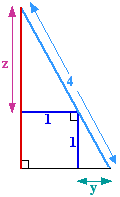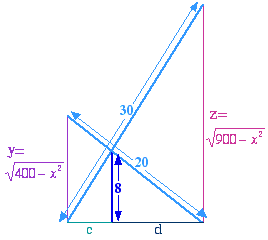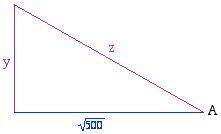Mar 2002
We received quite a few correct solutions for this month's puzzle. In case it defeated you, the key was to look for symmetries in the information you are given, and to use
similar triangles.
Part I
With  and
and  as in the diagram,
as in the diagram,  , so it is sufficient to find
, so it is sufficient to find  . By similar triangles,
. By similar triangles,  as
as  , so
, so 
By Pythagoras' Theorem,
But

, so
Solving this equation for

, and taking only the positive solution, yields
Now we find

.
So
and
Therefore
Part II
There are a number of approaches to this problem, but the one presented here follows from the observation that the information given is left-right symmetric - in other words, finding the two vertical heights will be equally easy (or hard!). We will label these two heights  and
and  , as in the diagram.
, as in the diagram.
By similar triangles, and dividing  up into two segments
up into two segments  and
and  , we see that
, we see that  as
as  and
and  as
as  ; therefore
; therefore
Adding gives

and multiplying gives

Combining these two results gives
Leaving this equation to one side for a moment, we can use Pythagoras' Theorem to find each of

and

in terms of our unknown

, as shown in the diagram above. Combining these two expressions gives that

.
Using Pythagoras' Theorem, we draw a triangle to represent this relationship:
On its own, the information in this diagram is not enough to solve the triangle - for that, we would need one more bit of information. But now we can use the identity  All we have to do is find some combination of trig functions of
All we have to do is find some combination of trig functions of  that takes the form
that takes the form  . Since
. Since  and
and  , it is easy to see that
, it is easy to see that
Using a calculator gives

and

. Therefore

 and
and  as in the diagram,
as in the diagram,  , so it is sufficient to find
, so it is sufficient to find  . By similar triangles,
. By similar triangles,  as
as  , so
, so 






 , so
, so ![\[ (z+y)^2 + 2(z + y) - 16 =0. \]](/MI/24d7f9cff87a2487c6c9584b4918bbff/images/img-0007.png)
 , and taking only the positive solution, yields
, and taking only the positive solution, yields ![\[ z+y = \sqrt{17}-1. \]](/MI/24d7f9cff87a2487c6c9584b4918bbff/images/img-0009.png)
 .
. ![\[ (z+y)^2 - (z-y)^2 = 4zy = 4, \]](/MI/24d7f9cff87a2487c6c9584b4918bbff/images/img-0011.png)












![\[ z+y = \sqrt{14 - 2\sqrt{17}} \]](/MI/24d7f9cff87a2487c6c9584b4918bbff/images/img-0019.png)









![\[ x = z+1 = 2.76 + 1 = 3.76. \]](/MI/24d7f9cff87a2487c6c9584b4918bbff/images/img-0024.png)

 and
and  , as in the diagram.
, as in the diagram. up into two segments
up into two segments  and
and  , we see that
, we see that  as
as  and
and  as
as  ; therefore
; therefore ![\[ z = 8x/c \mbox{ and} y=8x/d. \]](/MI/685c0474dcae63ada2bb964a886ebcf1/images/img-0008.png)
 and multiplying gives
and multiplying gives  Combining these two results gives
Combining these two results gives 








 and
and  in terms of our unknown
in terms of our unknown  , as shown in the diagram above. Combining these two expressions gives that
, as shown in the diagram above. Combining these two expressions gives that  .
.

 All we have to do is find some combination of trig functions of
All we have to do is find some combination of trig functions of  that takes the form
that takes the form  . Since
. Since  and
and  , it is easy to see that
, it is easy to see that ![\[ cos(A) + 1/tan(A) = \sqrt{500}(1/z + 1/y) = \sqrt{500}/8 = 2.7951. \]](/MI/8d26075d937cdef1118b9740259dc265/images/img-0006.png)
 and
and  . Therefore
. Therefore ![\[ x= \sqrt{900 - (25.24)^2} = 16.2. \]](/MI/8d26075d937cdef1118b9740259dc265/images/img-0009.png)